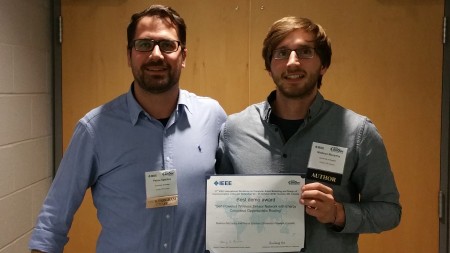Undergrad earns Best Demo award

Madison McCarthy, a U of G undergrad engineering student, recently received international accolades for his work that prevents isolated wireless network failures and helps ensure crucial data can get where it needs to be.
Together, McCarthy and engineering professor Petros Spachos received the IEEE Best Demo Award for their paper “Self-Powered Wireless Sensor Network with Energy Conscious Opportunistic Routing”.
The award was presented at the IEEE International Workshop on Computer Aided Modelling and Design of Communication Links and Networks (CAMAD). McCarthy competed against graduate students to win the honour.
McCarthy and Spachos built a prototype that lets networks prioritize information sent wirelessly to ensure critical messages get where they need to be faster. Information about an impending forest fire, for example, would follow a more efficient network path to its recipient than an advertising message would.
McCarthy’s work shines a light on U of G not just because it’s an innovative project, but also because the undergrad built and programmed the complete prototype here, on campus, from scratch. It’s a first for U of G and rare for many universities.
Post Doc wins for Best Paper
Post doc fellow Farzad Amirjavid also made a name for himself at the IEEE convention when he and Spachos received the IEEE Best Paper (Local) award for their “Network Coding in the Internet of Things” paper. The pair collaborated with Professor Liang Song from Henan University of Science and Technology and Professor Konstantinos Plataniotis from the University of Toronto.
Their submission detailed an algorithm Amirjavid and Spachos wrote that helps robots decide when to take action.
In his scenario, Amirjavid programmed a robot to sense when something was out of place in a home (in this case, a hazard on the floor) and to respond by moving to the location, taking a photo with its camera, and transmitting the photo to alert the resident.
Spachos sees the algorithm as having applications for seniors looking to live independently longer, so they can be made aware of dangers in their home.
Their work is of interest in the engineering world as use of the algorithm would allow data to travel directly between the robot and the user. It creates a better guarantee of privacy compared to other transmissions that are routed through a third-party server.